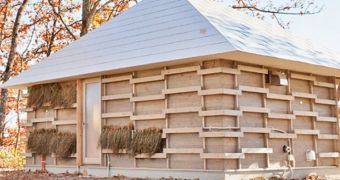Quite a lot of resources go into heating households during wintertime, and, too often, this translates into environmental pollution. The good news is that, thanks to a group of student designers at Japan's Waseda University, it could happen that, one day in the not so distant future, organic matter will be more than enough to heat homes.
Clean Technica informs that these greenheads have recently pieced together a prototype home whose inside is kept warm by composting organic matter. More precisely, the material that these specialists chose to work with is fermenting straw.
The Waseda University scientists explain that, while busy fermenting, straw lets out quite a lot of heat. Specifically, it has been documented to heat up to about 86 degrees Fahrenheit (30 degrees Celsius), the same source details.
In order to put the heat released by straw while composting to better use, the students who worked on this project merely placed straw inside acrylic boxes that made up their prototype home's walls. To ensure that the home would be residents-friendly, they opted for a low-odor composting technique.
By the looks of it, the fermenting straw proved fairly efficient in terms of getting the inside of the prototype home warm and cozy. The only problem was that, after four weeks, it stopped letting out heat, and therefore had to be replaced.
However, the Waseda University students say that, first off, this is a fairly small price to pay given the environmental benefits that come with using fermenting straw for heat. They also argue that, since most households don't require heating all year round, the method is not as big of a headache as some might think it to be.
Interestingly enough, student designers Masaki Ogasawara, Keisuke Tsukada and Erika Mikami claim that straw can be used not only to heat a home, but also to cool it. This is because, while drying, this form of organic matter releases moisture. Hence, straw put to dry inside transparent window shelving can easily act as a heat shield.
The official name for the prototype home created by design students Masaki Ogasawara, Keisuke Tsukada and Erika Mikami at the Waseda University is Recipe to Live. The house was erected in Taiki-cho town on Hokkaido Island, media reports say. The students settled on this location due to the fact that the region is home to quite a lot of dairy farms, which meant that access to straw was not going to be an issue.

 14 DAY TRIAL //
14 DAY TRIAL //